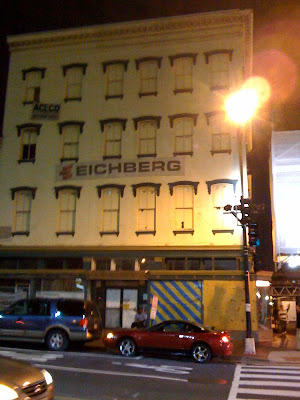 The design for the future National Museum of African American History and Culture on the National Mall checked off its first of a series of reviews today, when the National Capital Planning Commission (NCPC) heard a presentation from the Smithsonian Institution and their chosen architect, Freelon Adjaye Bond/SmithGroup, about the plans for the building.
The design for the future National Museum of African American History and Culture on the National Mall checked off its first of a series of reviews today, when the National Capital Planning Commission (NCPC) heard a presentation from the Smithsonian Institution and their chosen architect, Freelon Adjaye Bond/SmithGroup, about the plans for the building.  Though commissioners praised the quality of the design, many expressed "serious concerns" about the current design's size and massing in relation to the Mall and the Washington Monument. The design process is scheduled to last approximately 3 years, with construction beginning in 2012.
The 5 acres of land near the Washington Monument have been the subject of vociferous debate first with the National Park Service opposing its use for anything but the grassy space that exists today, then with 22 designs competing for the site and now with sundry federal and local agencies reviewing the merits of the design that won out over five other semi-finalists this past April. Bounded by Constitution Avenue, Madison Drive, 14th and 15th Streets NW, the site would be the terminus of the Smithsonian museums on the Constitution side of the mall, leading up to the Washington Monument.
Though commissioners praised the quality of the design, many expressed "serious concerns" about the current design's size and massing in relation to the Mall and the Washington Monument. The design process is scheduled to last approximately 3 years, with construction beginning in 2012.
The 5 acres of land near the Washington Monument have been the subject of vociferous debate first with the National Park Service opposing its use for anything but the grassy space that exists today, then with 22 designs competing for the site and now with sundry federal and local agencies reviewing the merits of the design that won out over five other semi-finalists this past April. Bounded by Constitution Avenue, Madison Drive, 14th and 15th Streets NW, the site would be the terminus of the Smithsonian museums on the Constitution side of the mall, leading up to the Washington Monument.
 The current design is what the architect described as a pavilion, its base embracing the mound-like structure at the base of the neighboring "temple" buildings, which include the Museum of Natural History and the American History Museum. The building then opens inwards like a "front porch" to reflect a structure common in both traditional West African and southern African American cultures, according to the architect. The mass of the building is aligned with the Museum of Natural History and it is no higher than the American History Museum.
The current design is what the architect described as a pavilion, its base embracing the mound-like structure at the base of the neighboring "temple" buildings, which include the Museum of Natural History and the American History Museum. The building then opens inwards like a "front porch" to reflect a structure common in both traditional West African and southern African American cultures, according to the architect. The mass of the building is aligned with the Museum of Natural History and it is no higher than the American History Museum.
 NCPC commissioners generally commented favorably on the concept, especially praising the interior design of the building. However, one after another, members expressed concern that the building would diminish the impressiveness of the Washington Monument because, as one commissioner put it, the design "failed" to maintain "the integrity of the mall." Other commissioners mentioned that part of the design process involved the architects providing three alternative design concepts, a process which would "improve the final project."
With the design far from finished, NCPC will hear from the team again in the spring of 2010.
NCPC commissioners generally commented favorably on the concept, especially praising the interior design of the building. However, one after another, members expressed concern that the building would diminish the impressiveness of the Washington Monument because, as one commissioner put it, the design "failed" to maintain "the integrity of the mall." Other commissioners mentioned that part of the design process involved the architects providing three alternative design concepts, a process which would "improve the final project."
With the design far from finished, NCPC will hear from the team again in the spring of 2010. 
Washington DC real estate development news


















 change to any developer, but tack on rules that make some lenders jittery.
Back in the days when no-doc loans were
change to any developer, but tack on rules that make some lenders jittery.
Back in the days when no-doc loans were 







 are public and 208 are private."
are public and 208 are private."  Whether or not construction will ever begin on the four story, 46-unit second phase of development remains to be seen. No date for Phase 2's construction has been set. That said, RST Development is pushing forward into the subcontracting stage of Phase 1 despite the setbacks in the market so far.
Whether or not construction will ever begin on the four story, 46-unit second phase of development remains to be seen. No date for Phase 2's construction has been set. That said, RST Development is pushing forward into the subcontracting stage of Phase 1 despite the setbacks in the market so far. 



















